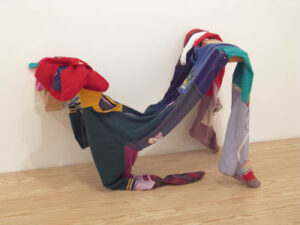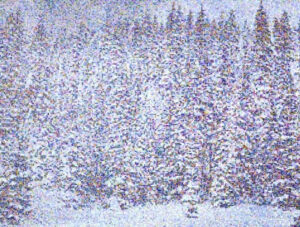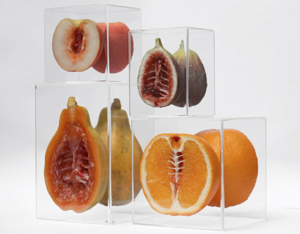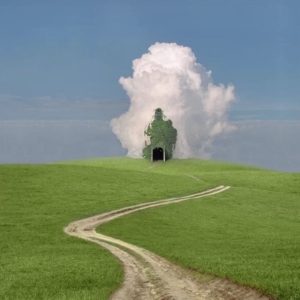If you do a search on the Internet for “terrifying things,” you will find a lot of people sharing their fears, including those of weird people’s strange behavior, urban legends, conspiracy theories, criminal cases, fear of Siri’s voice, and even the creepy microstructure of fruits. You can also find weird sculptures, brief Cthulhu myths, words without reason, images of endless corridors, and other things we refer to as weird.
The word “weird” in the dictionary typically refers to something that deviates from the ordinary and has supernatural or paranormal powers. In contemporary art, the field of weird art is also expanding. This post will discuss what kind of art I believe might be labeled “other/misc.” as well as “How exactly might a work of art become weird?”. Furthermore, I claim that anything ordinary can become uncanny.
What do I label as “other/misc.”? I believe that it represents artwork that is hard to categorize. When we see “other” listed as a category on a shopping website, we know that it contains products outside the mainstream categories (furniture, food, medicine, etc.). In this case, we can also refer to the esotericism definition – a term scholars use to categorize a wide range of loosely related ideas and movements that developed within Western society. These united ideas and currents representing esotericism are largely distinct from orthodox Judeo-Christian religion and Enlightenment rationalism. Western esotericism encompasses all of Western culture’s “rejected knowledge” that is accepted neither by the scientific establishment nor orthodox religious authorities. Similar to this, “other/misc.” in the art world refers to non-mainstream art or artwork that does not fall under one specific genre, also known as weird art. “They were fringe; they were weird.”(Ross, Sarah Gwyneth. ‘Weird Humanists’.)
Most weird art conveys feelings of mystery, confusion, disorientation, dread, alienation, and nostalgia through depictions of death, memory, dreams, and other themes. At the same time, weird art is not limited to any particular format; it can be a painting, an installation, a sculpture, or even a brief video, song, film, photograph, and so on.
When an artwork focuses on the artistic evocations and recall of “the past” and the culturally collective specters that haunt our present, people typically get a creeping sense of dissonance and temporal dislocation. “Uncanny is in reality nothing new or alien, but something which is familiar and old-established in mind and which has become alienated from it only through the process of repression.” (Sigmund Freud) A typical example of weird art is hauntology. The term “Hauntology” was first introduced by Derrida in his book Specters of Marx. Derrida claimed that even though Marx had passed away for many years, his ghost has continued to ‘haunt Western society from beyond the grave.’ However, hauntology has also been used in its most popular form to describe music, art, and film.
There is an example of hauntological art. D-L Alvarez is a sculptor who produced a series of sculptures called Something to Cry About. These bright children’s clothes are stitched together into vaguely humanoid shapes, reminding us of childhood and the footed pajamas of cartoon-addled kids. Additionally, the way they were hung over ominously suggestive wooden planks suggests that they were mourning for metaphorical childhood death, which evokes a sense of horror and weirdness by reminding people of their personal experiences in their childhood.


Another piece of art is a collection of pixelated paintings by Dan Hays titled Colorado Impression. Dan is two people; one lives in the UK and the other in the US. One day, UK Dan took digital photos of the natural beauty of his native nation and posted them on his website. However, it was these low-resolution photos that drew the eye of Dan Hays in the UK, who converted them, pixel by pixel, into paintings that were considerably larger than the originals. There is no doubt that hauntological art is associated with aging technology, such as videotapes, analogue radio, analogue noise on television, audiotape, and so on. However, Day Hays’ work makes us notice that once digital photographs too become a thing of memory and nostalgia, we’ll likely be haunted by ghosts made of jpeg compression artifacts. A satirical parody of the modernist idioms of Impressionism, Post-Impressionism, Pointillism, Cubism, and De Stijl may also be seen in Hays’ Colorado style. These deceased ancestors reappear in a blur through the glitchy representational technology of jpeg, evoking an affective sense of temporal disjuncture.


I consider that remixing and reconstituting commonplace items can provide an odd quality to a piece of art. Most weird art uses everyday objects we are familiar with rather than bizarre ones we have never seen. The artist mixes and matches different objects in a daring way to create a sense of unreality, whether on purpose or accidentally. Here we can draw on Sarah Gwyneth Ross’s definition of ‘weird’ in Weird Humanists: “I mean ‘weird’ in a wholly positive sense loosely connected to its magical connotation, indicating creative appropriation, wild deviations from norms, mixing and matching wantonly, being anything but monogamous in reading practices, and insisting on a kind of perilous playfulness. (Ross, Sarah Gwyneth. ‘Weird Humanists.’)
This is an example from a case study covered in my basho group. A hybrid species of skeletal fruit was created by the sculptor Monica Piloni; it is neither a fruit nor a skeleton but rather a species that lies in between the two ordinarily unrelated objects. Her art shows a weird skeletal structure concealed beneath the flesh of many fruits, including oranges, figs, and apples, which evoke feelings of both fascination and disgust.


Another typical art form is the collage. By combining common materials, collage can frequently arouse a ludicrous and surreal sense of the absurd. For example, In order to give the picture a dreamlike feel, dreamcore art frequently incorporates elements that are frequently found in dreams, daydreams, or nightmares. These symbols include eyes, fangs, wings, rainbows, familiar settings, bubbles, flowers, mushrooms, strange animals, and so on.


However, not all assembled objects evoke a sense of weirdness. “Although weird fiction is a profoundly hybrid form, central to attempts to define the weird as a genre has been its estrangement of our sense “(Benjamin Noys, Timothy S. Murphy; Introduction: Old and New Weird). It would not have been shocking if the artist had just sculpted several fruits because it did not alter how we think about fruit. Nevertheless, in the two instances above, the skeletal fruit and the surreal landscape “undermine the quotidian” (China Miéville) and “refashion the reader’s view of the world” (S. T. Joshi), respectively, which is what gives these works a highly peculiar appearance.
In conclusion, weird art is unclassifiable, outside the mainstream, and frequently arouses dread, mystery, and nostalgia in viewers. This strange feeling arises when a piece of art evokes memories of the past through sampling and editing. Sometimes weird art doesn’t refer to the mysterious, unknowable, or unnameable; instead, it happens when an artist combines two or more unconnected ordinary objects.
Citations used in this page:
- Derrida, J. (1994). Spectres of marx. New Left Review, 0(205), 31. Retrieved from https://www.proquest.com/scholarly-journals/spectres-marx/docview/1302004378/se-2
- Freud, S., 2015. “The Uncanny” (1919) by Sigmund Freud. [online] “The Uncanny” (1919) by Sigmund Freud. Available at: <http://web.mit.edu/allanmc/www/freud1.pdf> [Accessed 18 March 2015].
- Harper, Adam. ‘Rouge’s Foam: Hauntology: The Past Inside The Present’. Rouge’s Foam, 27 Oct. 2009, http://rougesfoam.blogspot.com/2009/10/hauntology-past-inside-present.html.
- D-L Alvarez | Exhibitions | MutualArt. http://bampfa.berkeley.edu/exhibition/243. Accessed 30 Sept. 2022.
- designboom, nina azzarello I. ‘Monica Piloni Sculpts a Species of Hybrid Skeletal Fruit’. Designboom | Architecture & Design Magazine, 20 Nov. 2015, https://www.designboom.com/art/monica-piloni-hybrid-skeletal-fruit-11-20-2015/.
- Tate. ‘“Colorado Impression 11b (after Dan Hays, Colorado)”, Dan Hays, 2002’. Tate, https://www.tate.org.uk/art/artworks/hays-colorado-impression-11b-after-dan-hays-colorado-t07946. Accessed 30 Sept. 2022.
- ‘Western Esotericism’. Wikipedia, 15 Oct. 2022. Wikipedia, https://en.wikipedia.org/w/index.php?title=Western_esotericism&oldid=1116181088.
- Benjamin Noys, Timothy S. Murphy; Introduction: Old and New Weird. Genre 1 July 2016; 49 (2): 117–134. doi: https://doi-org.ezproxy.is.ed.ac.uk/10.1215/00166928-3512285
- Ross, Sarah Gwyneth. ‘Weird Humanists’. I Tatti Studies in the Italian Renaissance, vol. 22, no. 2, Sept. 2019, pp. 345–54. DOI.org (Crossref), https://doi.org/10.1086/705397.
For more details about what I do in this course, please click the link below:





s2430290
20th October 2022 — 12:40 pm
Chenyan showed a interesting understanding of “weird studies” due to her artworks research. In her blog, she has presented some thinkable ideas such as what kinds of materials and concepts to construct within a weird artwork, and “weird” produce a surreal sense of the absurd or get a creeping sense of dissonance and temporal dislocation. I was very impressed by the artwork of hauntology, from the concept of making this humanins sculpture to a personal experience in childhood. The process of how to make a weird artwork give me some senses and ideas. I think Chenyan done a good artistic research in “weird studies”.
s2444627
20th October 2022 — 1:33 pm
The blogger’s ideas are very informative, thanks for sharing them. But are weird artworks only produced in the two ways mentioned above? Are there other ways? What is the idea that these weird artworks are trying to convey?
s2444438
20th October 2022 — 3:53 pm
This blog provides the reader with a wealth of information and resources for understanding ‘other/misc’ and how to make artwork look ‘weird’. Firstly, the author’s act of understanding ‘other/misc’ in relation to the concept of ‘mysticism’ is very original, but to summarise ‘other/misc’ as ‘unclassifiable artwork’ seems to me to be a bit of a stretch as “artefacts that are difficult to classify” does not seem to me to be precise enough. ‘Other’ is a term opposed to ‘us’, just as “western mysticism” is opposed to the Western scientific community and orthodox religious authorities, and the concept is not isolated, but exists in relative terms.
Furthermore, the author’s observation that ‘remixing’ contributes to the “weird” of the artwork is interesting; it is also quoted at the end that ‘at the heart of weird is alienation’. It would have been better if the author had thought further about how ‘remixing is linked to “alienating”.
s2419012
21st October 2022 — 4:06 pm
The structure of the article is complete, the narrative is clear, and echo head to tail. I agree with the statement that you label weirdness as other/misc because I have also read that weird is opposite to dominant culture in the cultural system. The article mainly focuses on Hauntology and well combined with contemporary art, and it can see that you have in-depth research and insights on the subject. I like that you explain your research with lots of examples and interspersed with pictures of artworks in the text, it makes it easier for me to understand what Hauntology is talking about.
s2358907
21st October 2022 — 6:03 pm
The blogger’s answers to the problem scenarios were very good and inspired me. Thank you.
But the meaning behind the artwork would like to be explained.
s2341902
22nd October 2022 — 10:15 pm
chenyan gives her views on weird study and gives a lot of interesting examples in the article, which is very good to understand.